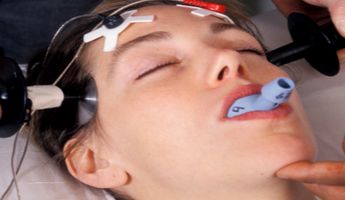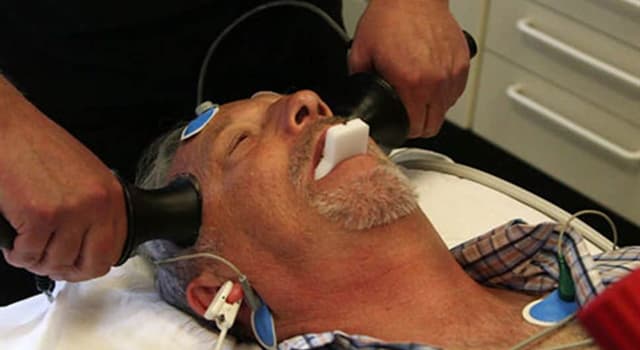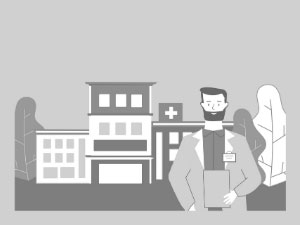Electroconvulsive Therapy (ECT) in Portugal
Search and Compare the Best Clinics and Doctors at the Lowest Prices for Electroconvulsive Therapy (ECT) in Portugal

Find the best clinics for Electroconvulsive Therapy (ECT) in Portugal
No clinics available

- Home
- Portugal
WHY US?
At Medijump, we're making medical easy. You can search, compare, discuss, and book your medical all in one place. We open the door to the best medical providers worldwide, saving you time and energy along the way, and it's all for FREE, no hidden fees, and no price markups guaranteed. So what are you waiting for?

Free

Best Price

Widest Selection

Risk-Free
What you need to know about Electroconvulsive Therapy (ECT) in Portugal

Electroconvulsive therapy (ECT) is a procedure that involves passing a carefully controlled small electric current through the brain to trigger a brief seizure. It causes changes in brain chemistry and aims to relieve severe psychiatric conditions.
ECT is usually performed when other treatments are unsuccessful. It is usually used to treat:
-
Treatment-resistant depression, which is a severe depression that does not improve with medications or other types of treatments.
-
Severe depression, especially when accompanied by psychosis (detachment from reality), a refusal to eat, or a desire to commit suicide.
-
Severe mania that can occur as parts of bipolar disorder, such as a state of intense euphoria, hyperactivity, agitation, impaired decision-making, and psychosis.
-
Agitation and aggression in individuals with dementia.
-
Catatonia, which is associated with schizophrenia, certain other psychiatric disorders, or medical illness.
Your doctor may also recommend ECT if you cannot tolerate medications or all other forms of therapy have not worked.
What is the cost of Electroconvulsive Therapy (ECT) in Portugal?
When computing the final cost of the Electroconvulsive Therapy (ECT) in Portugal, it's crucial to consider the multiple elements that factor into the total fee. The cost isn't exclusively limited to the procedure's price but involves the count of sessions needed, the fee for the anesthesiologist, costs for pre-surgery tests, charges for the facility, and the pricing for extra medicines to be used.
Getting a pricing quote from a preferred clinic is an ideal first step towards quantifying the cost, as they can give a more precise breakdown aligned to your personalized necessities and situations. While the Electroconvulsive Therapy (ECT) might inflict substantial financial strain, it's important to evaluate the cost against the prospective advantages. Fast alleviation of severe symptoms, shortened hospital stays, and less use of health services owing to failed treatment trials, all contribute towards the overall cost-efficiency of this medical procedure.
What does the Procedure Involve?
At the beginning of an ECT, you will receive general anesthesia and a muscle relaxant to help prevent injury and minimize the seizure. Your doctor will place a blood pressure cuff around one of your ankles to stop the muscle relaxant medications from entering foot and entering the muscles there. This is done to enable your doctor to monitor seizure activity by watching for any movement on that foot. You may also be given oxygen through an oxygen mask and a mouth guard to help protect your tongue and teeth from injury. Then, your doctor will place electrode pads on your head. The electrode pads are connected to the ECT machine.
Once you are asleep, your muscles are relaxed, and the necessary equipment is in place, your doctor will press a button on the ECT machine to pass a small amount of electric current through the electrodes to your brain, which produces a seizure that lasts less than 60 seconds. Due to the anesthetic and muscle relaxant, you will not be aware of the seizure. The visible effects of the seizure will usually be limited to the movement of your foot if a blood pressure cuff is placed around your ankle.
Your doctor may use a test called an electroencephalogram (EEG) to record the electrical activity in your brain. The beginning of a seizure is signaled by sudden, increased activity on the EEG and a leveling off shows that the seizure is over.
How Long Should I Stay in Portugal?
ECT can be performed on an outpatient basis, meaning you can leave the hospital on the same day. However, the length of your stay in Portugal while undergoing a Electroconvulsive Therapy (ECT) is largely determined by your personal health state and the number of treatment sessions proposed by your healthcare provider. Treatment typically involves two to three sessions per week, accumulating to six to twelve sessions in total.
Commonly, you would be required to reside in the Portugal throughout the course of the treatment. The total duration not only factors in the treatment sessions but also the requisite rest time post-treatment, typically a couple of hours for the anesthesia effects to dissipate after each session. Moreover, you might need to consider post-treatment consultations for tracking progress and if required, revisions to the treatment plan. Because of these factors, you might want to plan on staying in the Portugal for several weeks. Yet, it's highly advised to confer about the specific timeframe and aftercare process with your healthcare professional to ensure a comprehensive understanding and effective treatment path.
What's the Recovery Time?
Most people can return to their normal daily activities just a few hours after ECT. However, some people may be asked to avoid making important decisions, going back to work, or driving for one to two weeks following the last ECT treatment in a series. The recovery time until you can resume your activities generally depends on when confusion and memory loss after the procedure are resolved, so make sure to talk to your doctor about your specific recovery timeline.
What About Aftercare?
Here are a few aftercare instructions you need to consider:
-
Your doctor may give you antidepressants to help decrease or prevent symptoms of depression. They may also give you medicine to help with headaches that you may experience after each treatment. Always make sure to take the medicine as directed.
-
There is a high chance that you will fall after ECT treatments. Ask someone to help you stand up or walk and keep an eye on you during your recovery period.
What's the Success Rate?
Research has shown that ECT is a highly effective therapy for several mental health conditions. Around 80% of patients with uncomplicated but severe depression experience substantial improvement after their treatments.
ECT is a highly misunderstood procedure because, in the past, the side effects can be severe. However, while ECT does have some side effects and risks, it is much safer today. The risks and side effects include confusion, memory loss, adverse reaction to anesthesia, increased blood pressure and heart rate, headache, nausea, and muscle ache.
Are there Alternatives to Electroconvulsive Therapy (ECT)?
Below are some of the alternatives to ECT:
-
Transcranial Magnetic Stimulation (TMS) involves using rapidly alternating magnetic fields to stimulate specific areas in the brain. It is often used to treat depression.
-
Vagus Nerve Stimulation (VNS) was initially developed to treat seizure disorders, but it can also be used to treat depression. In this procedure, an electric pulse generator is implanted under your skin to stimulate the vagus nerve in the neck.
What Should You Expect Before and After the Procedure
Prior to the Electroconvulsive Therapy (ECT), your medical professional will provide you with comprehensive instructions relating to preparations, such as dietary guidelines and adjustments to your medication. A detailed psychiatric and medical examination will also be performed, encompassing various tests such as blood work, an ECG, and potentially a full physical evaluation, to confirm your physical health and suitability for the procedure. Furthermore, having a trustworthy support network is key to accompany you to the medical facility, offer emotional comfort, and assist in managing your aftercare.
Post the Electroconvulsive Therapy (ECT), your condition will be closely observed in a recuperation area. You might feel befuddled, lose your sense of direction, or struggle with memory loss immediately, however, these reactions are short-term and usually disappear within an hour. Once your condition stabilizes, you can safely return home under the guardianship of another person as your cognitive and motor abilities might be momentarily affected.
Before ECT, you may have a certain mental health condition and experience severe symptoms that are thought to be life-threatening or they do not improve after other treatment options. After the treatment, you may notice an improvement in your symptoms, which may take around six weeks.
What are Potential Risks of Electroconvulsive Therapy (ECT)?
Generally, the Electroconvulsive Therapy (ECT) is considered safe, but as with all medical procedures, it has potential hazards. Typical side effects are headaches, muscular discomfort, queasiness, and upchucking, which usually diminish swiftly with rest and medication. More severe hazards include possible health complications like cardiac issues, predominantly in individuals with existing heart diseases. Moreover, some patients may exhibit temporary disorientation right after the procedure, but this usually resolves within an hour. They might also have difficulties recollecting events that happened shortly before the treatment or in the weeks or months leading up to the treatment.
Risks associated with the procedure are usually reduced through a comprehensive pre-procedure assessment, encompassing a detailed medical history, physical examination, and diagnostic testing.
Whilst the information presented here has been accurately sourced and verified by a medical professional for its accuracy, it is still advised to consult with your doctor before pursuing a medical treatment at one of the listed medical providers
No Time?
Tell us what you're looking for and we'll reachout to the top clinics all at once
Enquire Now

Popular Procedures in Portugal
Prices Start From $28

Prices Start From $20

Prices Start From $28

Prices Start From $32

Recommended Medical Centers in Portugal for procedures similar to Electroconvulsive Therapy (ECT)

- Interpreter services
- Translation service
- Religious facilities
- Medical records transfer
- Medical travel insurance
- Health insurance coordination
- TV in the room
- Safe in the room
- Phone in the room
- Private rooms for patients available

- Interpreter services
- Translation service
- Religious facilities
- Medical records transfer
- Medical travel insurance
- Health insurance coordination
- TV in the room
- Safe in the room
- Phone in the room
- Private rooms for patients available

- Interpreter services
- Translation service
- Religious facilities
- Medical records transfer
- Medical travel insurance
- Health insurance coordination
- TV in the room
- Safe in the room
- Phone in the room
- Private rooms for patients available

- Interpreter services
- Translation service
- Religious facilities
- Medical records transfer
- Medical travel insurance
- Health insurance coordination
- TV in the room
- Safe in the room
- Phone in the room
- Private rooms for patients available

- Interpreter services
- Translation service
- Religious facilities
- Medical records transfer
- Medical travel insurance
- Health insurance coordination
- TV in the room
- Safe in the room
- Phone in the room
- Private rooms for patients available

- Interpreter services
- Translation service
- Religious facilities
- Medical records transfer
- Medical travel insurance
- Health insurance coordination
- TV in the room
- Safe in the room
- Phone in the room
- Private rooms for patients available

- Interpreter services
- Translation service
- Religious facilities
- Medical records transfer
- Medical travel insurance
- Health insurance coordination
- TV in the room
- Safe in the room
- Phone in the room
- Private rooms for patients available

- Interpreter services
- Translation service
- Religious facilities
- Medical records transfer
- Medical travel insurance
- Health insurance coordination
- TV in the room
- Safe in the room
- Phone in the room
- Private rooms for patients available
Electroconvulsive Therapy (ECT) in and around Portugal
Introduction
Portugal is a country located in southwestern Europe. It’s one of the oldest nation-states of Europe and the world. Its territory had been continuously invaded, settled, and fought over since prehistoric times. Today, the country has become a major tourist destination, with its architecturally stunning cities, cobblestone villages, medieval castles, great food, stunning beaches, and incredible weather. Besides its beauty, Portugal is also attracting people from all around the world for its healthcare. The country offers a combination of state-of-the-art private medical centers, with spotless facilities and private rooms, a wide range of procedures, with very short waiting lists, as well as highly trained patient-oriented medical teams who are fluent in different languages. The physicians in this country have been trained by high standard medical schools, where just top and talented students are allowed to attend.
Popular Cities and Regions in Portugal
Lisbon is the capital and the largest city in Portugal. This city is filled with friendly people, history, mystique, and amazing food. Explore its many beautiful churches, listen to Fado, take a trip to the Castle of St. Jorge, see Sintra, and have some fun in one of its nightclubs. Another popular destination is Batalha, which is home to the UNESCO-listed Batalha Monastery. The monastery was build from 1386 to 1517 and is known as the greatest Gothic masterpieces in Europe. Those who want to party or soak up the sun should visit Lagos, while those who love to wander around and visit museums should visit Porto. Both of these cities are popular and fascinating.
Transport in Portugal
International tourists usually arrive at Lisbon Airport. It is a hub for low-cost airlines EasyJet and Ryanair, and it serves flights to numerous cities around the world. To get around Portugal, trains and buses are very efficient. While trains are often cheaper, buses are usually quicker. Taxis are available in almost every city and are relatively cheap.
Visas in Portugal
Since Portugal is part of the Schengen Area, citizens of 62 countries, including the US, Australia, the UAE, and Canada, are allowed to visit without a visa for up to 90 days. Citizens of most other countries are required to obtain a Schengen visa to visit the country.
Weather in Portugal
From March to May it is spring and the weather is pleasant but there will likely be some heavy rain. Summer, is from June to mid-September, can be scorching hot with temperatures rising to mid 30oC. Autumn, starts from mid-September to December and it brings colder temperatures but and an increased chance of rain. Winter can get quite cold and the days are shorter and always expect rain and storms during this season.
Additional Info
- Local Currency: The euro is the official currency. 1 EUR is equivalent to 1.08 USD.
- Money & Payments: ATMs are widely available, except in small villages. Credit cards are often accepted at midrange and high-end establishments. Tipping is usually expected at hotels and restaurants.
- Local Language: The official language is Portuguese. However, English, French, and Spanish are widely spoken in the country.
- Local Culture and Religion: Christianity is the major religion of the country. Other religions are practiced by a small portion of the population.
- Public Holidays: Portugal Day, Restoration of Independence, and Christmas Day are some of the public holidays celebrated in Portugal.
Popular Searches
- Plastic Surgery in Thailand
- Dental Implants in Thailand
- Hair Transplant in Thailand
- Breast Augmentation Thailand
- Gastric Sleeve in Thailand
- Gender Reassignment Surgery in Thailand
- Laser Hair Removal in Bangkok
- Botox in Bangkok
- Dermatology in Bangkok
- Breast Augmentation in Bangkok
- Coolsculpting in Bangkok
- Veneers in Turkey
- Hair Transplant in Turkey
- Rhinoplasty in Turkey
- Stem Cell Therapy in Mexico
- Rhinoplasty in Mexico
- Liposuction in Mexico
- Coolsculpting in Tijuana
- Rhinoplasty in Korea
- Scar Removal in Korea
- Gastric Sleeve in Turkey
- Bone Marrow Transplant in India
- Invisalign in Malaysia
- Plastic Surgery in the Dominican Republic
- Tummy Tuck in the Dominican Republic
- Plastic and Cosmetic Surgery in Poland
- Rhinoplasty in Poland
- Hair Implant in Poland
- Dental Implants in Poland
- IVF in Turkey